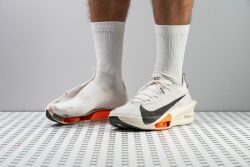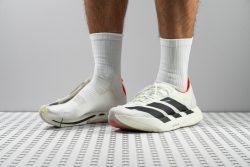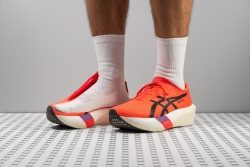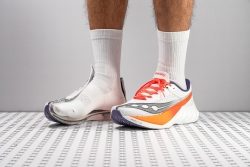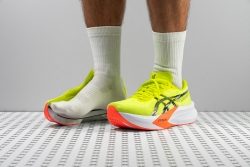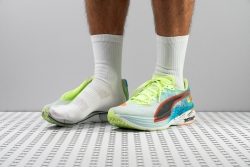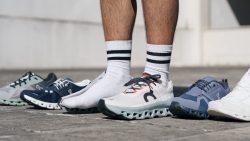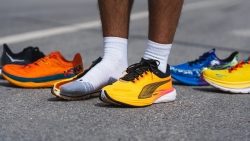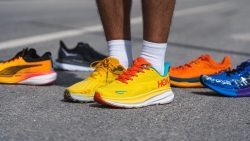7 Best Half Marathon Running Shoes in 2025
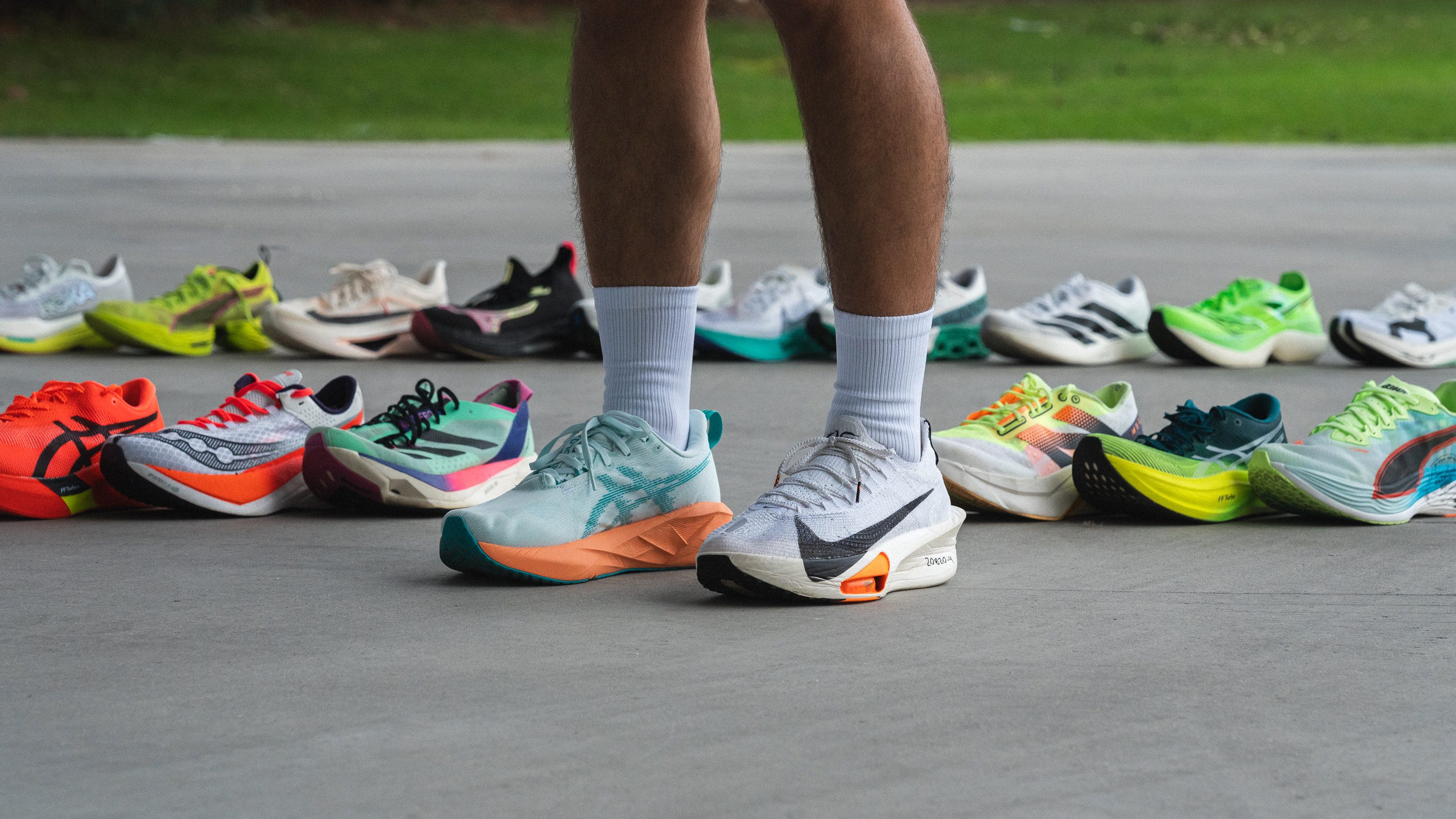
We buy shoes ourselves. We earn commissions when you buy through us, at no extra cost. Why trust us
From short distances to 42k, there's quite a lot of wiggle room feature-wise. Thinking about foams, shoe weight, stack height, and all the other factors can be overwhelming. Here, we break down the key features needed in half-marathon running shoes and why they matter.
If you want a short answer, look at our selection of top picks. We picked those shoes after thoroughly testing them in and outside of the lab. And, for more nerdy details and data points, read our guide section.
How we test half marathon running shoes
We test running shoes on our runs and in our lab. During the test runs, we take notes of everything, from comfort and energy return to outsole durability and breathability. We then cut the shoes in half and test them in our lab. We end up with more than 20 points that usually confirm our experience with the shoe. The best thing about lab tests is that we get to quantitatively describe the shoe.
All these data points allow us to compare the running shoes and better understand each one's performance.
Best half-marathon running shoes overall










































































What makes it the best?
The Nike Alphafly 3 is the cream of the crop among half-marathon running shoes we tested on foot and in the lab because of its exceptionally responsive ride and weightlessness. With top-notch features like the FlyPlate, Air Pods, and the ZoomX cushioning, it ensures a comfortable ride even at high speeds.
Made for competitive paces, Alphafly 3 helped us fly to the finish line. Our scales confirm the airiness we felt as it weighs 7.1 oz (201g), 24.2% below average. Its massive energy return adds to its effortless feel. Our lab analysis reveals the stiff FlyPlate and Air Pods that make it consistently responsive. As proved by our bend test, it’s 150.7% more rigid than average.
The ZoomX cushioning is also a star, exhibiting both a soothing and electrifying aura. It measures a tall 38.1/33.7 mm for impact protection and is made of two foam densities for specific reasons: the top is a firmer 29.3 HA for support while the bottom is a plush 18.1 HA. Altogether, the ride feels very bouncy and aggressive.
This shoe is made for runners seeking peak performance and we think its $285 price tag is worth it. However, those on a budget can find more affordable options.
Pros
- Remarkably lightweight despite its broad size
- Best-in-class breathability
- Excels in the marathon distance
- Repositioned Air Pods offer a better ride than the v2
- ZoomX foam delivers massive energy return
- Aids in forward momentum, especially when legs begin to fatigue
- Better than ever for 5K/10K racing
- Finally smooth transitions!
Cons
- Heel strikers might wear down the outsole quickly
- The arch could still be a challenge for some
- The sock-like tongue might not suit everyone
Half-marathon running shoes with the best energy return
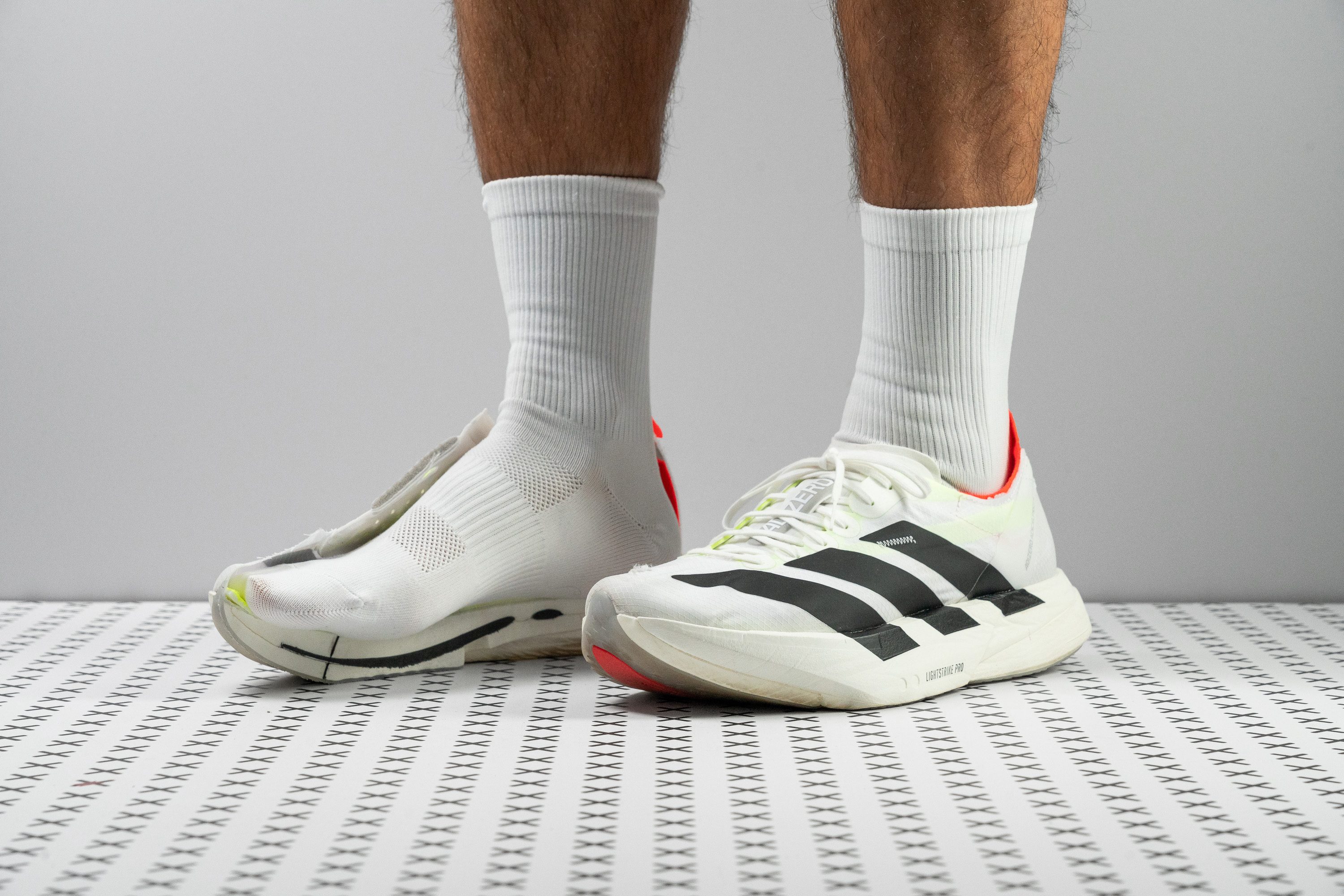



























































What makes it the best?
It’s tough to find a supershoe that matches the speed, stability, and outsole quality that the Adidas Adizero Pro 4 brought in our runs. Numbers checked it’s our half-marathon shoe with the best energy return while ensuring controlled strides.
The AP4 has five carbon-infused rods that make the ride highly responsive. Every stride was filled with power, and our bend test confirms it’s 51.3% stiffer than average—a result that clearly backs up the spring we experienced without feeling too rigid.
Another feature that brings otherworldly propulsion is the midsole foam. In the lab, it recorded high energy return scores of 80.4% in the heel and 80.3% in the forefoot. During our runs, the extra push was undeniable since the average is only at 58.3% and 60.5%, respectively.
The LIGHTTRAXION outsole delivers the extra bite needed to speed through fast corners or wet roads confidently. It suits its name because its thin 1.0 mm measurement makes the shoe feel light. It managed to keep its rubber thin because of its impressive wear resistance. Our Dremel test left it with a minimal 0.8 mm dent vs. the 1.0 mm average.
Unfortunately, AP4 won’t be stable enough for rear strikers because of its narrow heel. These types of runners need a vast landing base.
Pros
- Softer, bouncier Lightstrike Pro foam
- Maintains the same price
- No more heel slippage
- Versatile from 5K to marathon distances
- Durable outsole with outstanding grip
- Fantastic for midfoot and forefoot strikers
- Improved for faster runners
- Comfortable, gusseted tongue
- Lighter than Adios Pro 3
Cons
- Unstable for every heel striker
- Narrow, tapered toebox
- Upper lacks breathability
- Midsole loses bounce quicker than AP3
Half-marathon running shoes with the best shock absorption
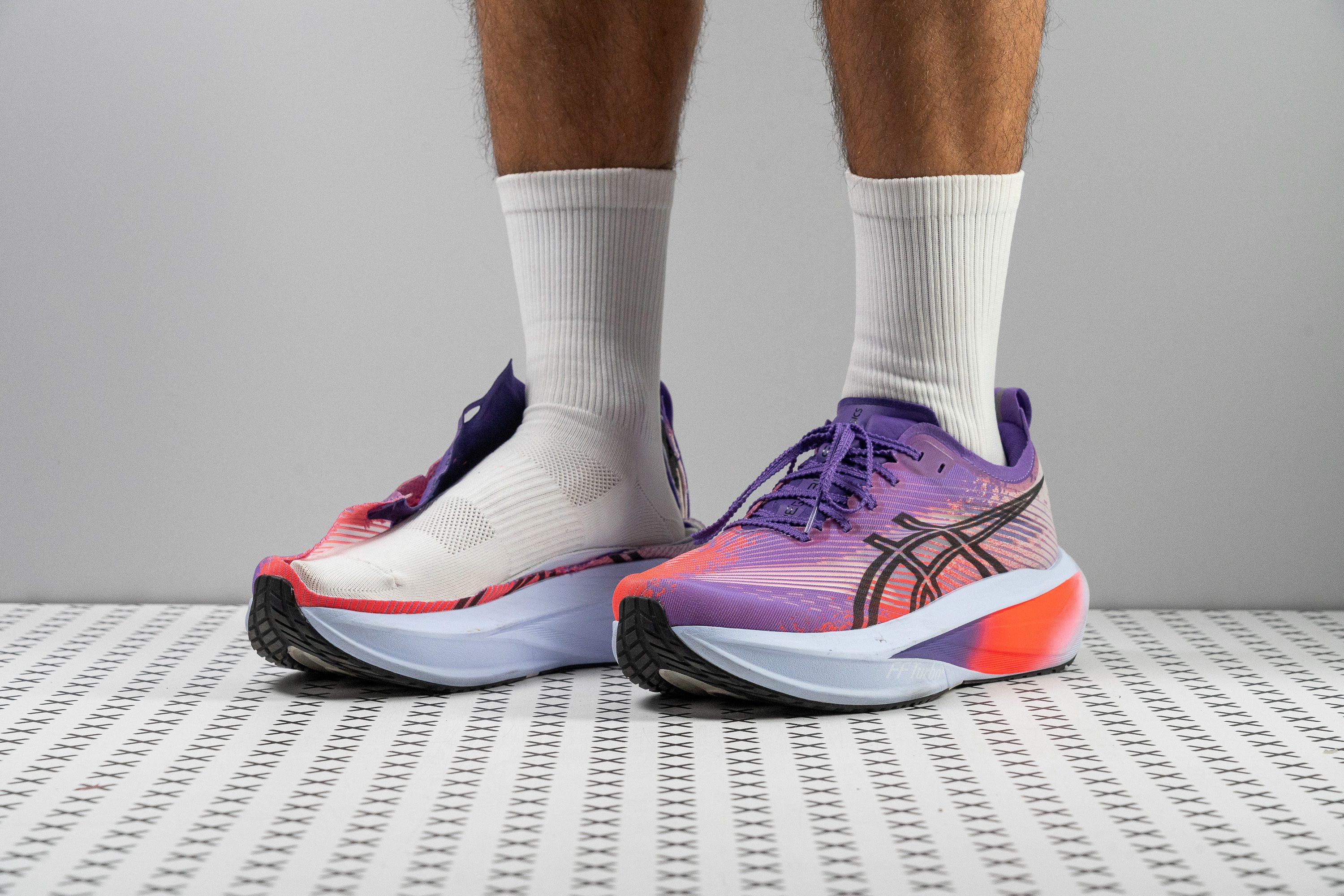
















































What makes it the best?
The ASICS Megablast superbly blends impact protection and responsiveness in one shoe, making it a great companion for longer distances. It delivers raw speed through its high-energy foam that pushes us to our best pace. The power output is out of this world, complemented by its light build offering smooth strides and its comfort-loaded midsole keeping our legs fresh for the final miles. Ultimately, based on our lab figures, it’s our best shock-absorbing half-marathon running shoe.
Our lab results speak to the plush sensation and responsiveness we experienced. The Megablast features a mega 45.1/35.2 mm stack, made of foam that absorbs impact well, confirmed by above-average shock absorption scores of 160 SA in the heel and 144 SA in the forefoot.
We can’t help but test the solid rebound we experienced, and the cushion returned massive ratings of 73.0% and 73.8% in the heel and forefoot, respectively.
This racer is all about agility. Despite being loaded with comfort, it weighs a featherlight 7.8 oz (218g), while other running shoes average 17.7% heavier.
Unfortunately, its outsole performed poorly in our durability tests. We recommend saving this pair for race days and avoiding unpaved surfaces to prolong its life.
Pros
- Outstanding energy return
- Exceptional impact protection
- Durable, grippy outsole rubber
- Astonishingly low weight
- Performs at any pace and distance
- Breathable, lightweight upper
- High-quality materials from heel to toe
- Suitable for all footstrikes
- Top performance without a carbon plate
Cons
- Extremely expensive for a training shoe
- Limited outsole coverage
- Poor toebox durability
Best lightweight half-marathon running shoes




















































What makes it the best?
The ASICS Metaspeed Edge Tokyo honors its name by delivering speed through its powerful midsole, pushing us to our best pace. The energy return is out of this world, complemented by its sky-high stack protecting our joints. All these and more are packed in a minimal package, making it our best lightweight half-marathon running shoe.
The Metaspeed Edge Tokyo melted away and never burdened us during flat-out efforts. It weighed as light as a feather at 5.6 oz (159 g), while other lab-tested racers averaged 23.2% heavier, and the average running shoe, 40.0% heavier! Its airiness is undeniable!
Our lab results speak for the responsiveness we experienced. Metaspeed Edge Tokyo propels us forward with every stride through its carbon plate and FF Leap foam. Testing for the midsole’s energy return, we got whopping scores of 78.3% (heel) and 76.8% (forefoot).
Thankfully, this racer doesn’t forego comfort, allowing us to pursue longer distances. The stack is massive at 38.9/32.0 mm, with exceptional shock absorption scores of 146/132 SA. Even in the last mile, our feet didn’t feel beat up.
However, its superior performance comes with a premium $270 price tag. Runners who are not willing to invest this much can try out other pairs.
Pros
- Light as a feather
- Excels at any distance, from 5K to the marathon
- Elite-level traction
- New FF Leap midsole is super responsive
- More stable than the Metaspeed Sky Tokyo
- Plush forefoot
- Excellent upper
- Classic rolling feel from curved plate
- Better than Metaspeed Edge Paris in every way
Cons
- Price increase
- Narrow fit
- Not stable
Best half-marathon running shoes for heel strikers
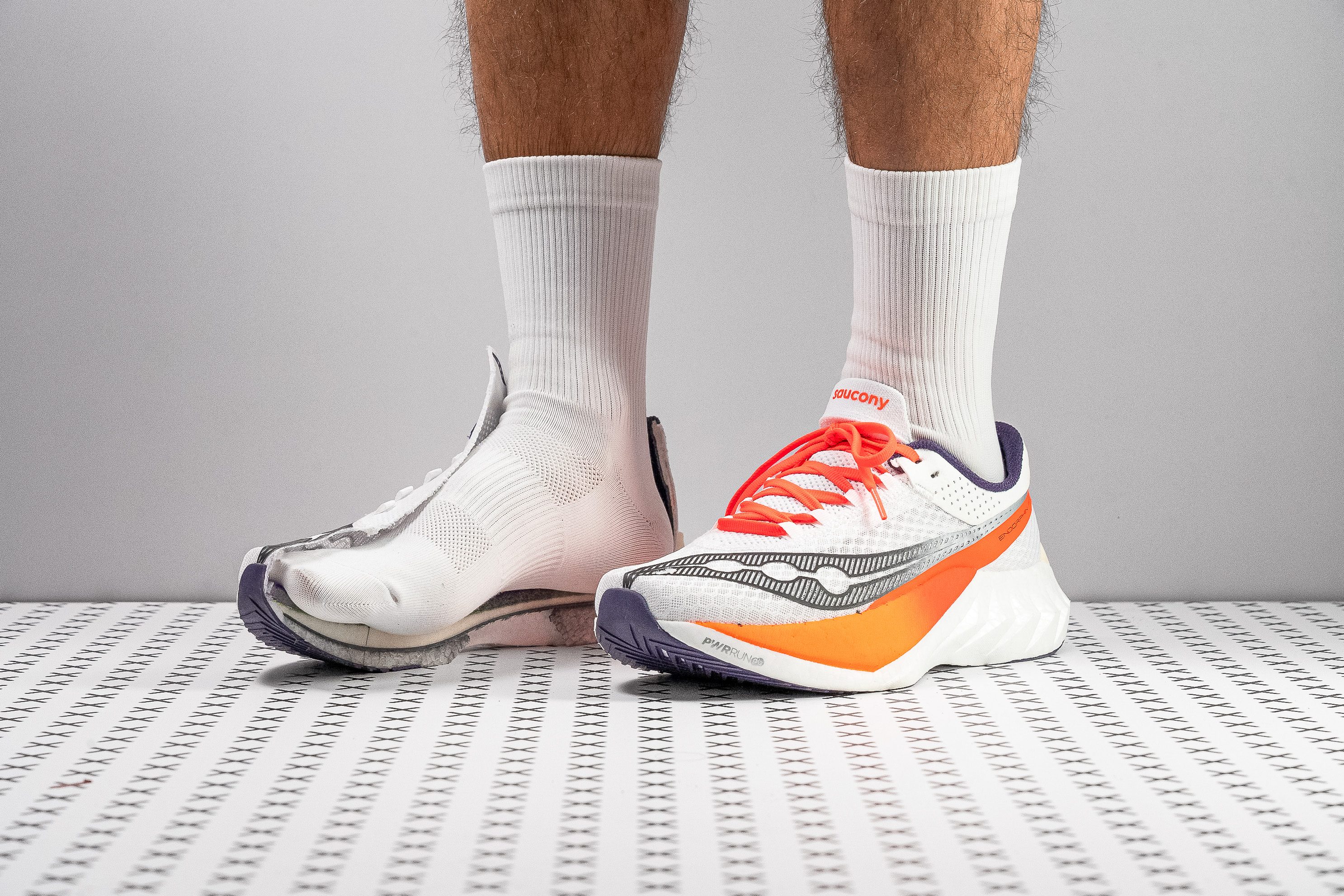
























































What makes it the best?
The Saucony Endorphin Pro 4 proves a competitive shoe can be comfortable and durable. It exhibited pure speed in our runs through its vibrant midsole, complemented by the Speedroll technology. Analyzing our cut-in-half shoe in the lab further proves it’s the best half-marathon shoe for heel strikers.
EP4 is undeniably a powerhouse thanks to its rigid S-shaped carbon plate that promotes silky smooth turnover and strong momentum. Our bend test verifies the midsole is 141.6% stiffer than average, translating to massive energy output.
The carbon plate lies between two distinct foams: a plush and bouncy 18.5 HA top layer and a balanced 22.0 HA base layer for enhanced stability, both features we truly appreciated in the latter miles of our Half Mary. Additionally, the 38.1 mm heel cushioning erases any ground impact. Paired with a modest forefoot, the 9.5 mm drop feels more natural for rear strikers.
Underfoot, the XT-900 rubber surprised us with its robust nature. At 85.3 HC, it’s tougher than most racers and even our 80.1 HC lab average! We tested its strength further in our abrasion test and it emerged victorious with a minimal scuff, making it highly resistant to wear.
The shoe feels light at 7.8 oz (220g), yet in this era of weightless shoes, other elite racers will feel even faster.
Pros
- Durable upper and outsole
- Spacious upper fit
- Enhanced midsole comfort
- Great value at $225 for a supershoe
- Versatile across all paces
- Ideal for heel strikers
- More stable than ever
Cons
- Slightly heavier than v3
- Less suited for forefoot strikers
- Competitors may feel quicker
Half-marathon running shoes with the best traction
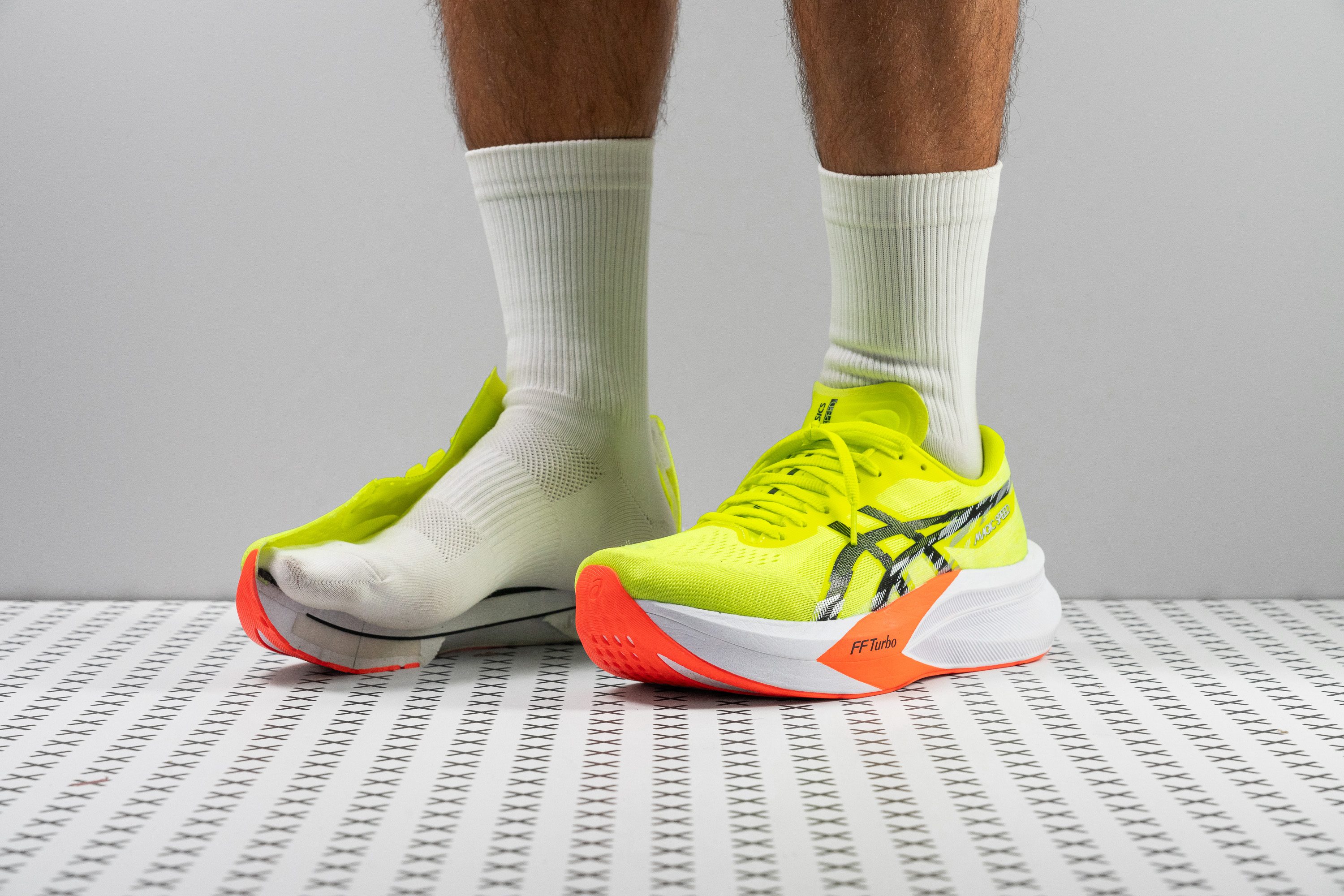
































































What makes it the best?
The ASICS Magic Speed 4 delivers such a surefooted feel that we didn’t have to think twice when running through rain or puddles. Our lab tests confirm it offers a solid grip and a well-cushioned yet springy platform in a lightweight package. Ultimately, it leads in traction among half-marathon running shoes.
Starting with its superior ASICSGRIP rubber, it dominated our traction test with an unbelievably high 0.81 friction rating that’s hard to match. For comparison, it’s 76.1% grippier than average, leaving zero doubts about running through slippery, sandy, or dry surfaces.
The skyscraper stack offers endless comfort for long runs. It surpasses the average and even the race-legal 40-mm limit with its 42.5/32.9 mm stack height. On top of this, it achieved solid shock absorption scores of 144/122 SA in the heel and forefoot, respectively. Underfoot, this combination leads to pillowy landings and maximum joint protection.
Thankfully, the shoe doesn’t feel bulky. Its forefoot has the FF Turbo foam, which contributes to its higher energy return of 61.8%. Additionally, the shoe actually weighs light at 8.4 oz (237g), 10.6% below average, boosting our agility.
Unfortunately, its uber-soft, tall, and narrow platform leads to poor stability. Runners who need extra guidance should go for a more supportive shoe.
Pros
- Enhanced midsole
- Exceptional grip
- Superior durability
- Awesome traction
- Excellent value for a supertrainer
- Colossal cushioning
- Carbon plate!
- Ideal for marathon-paced workouts
- Fantastic upper
Cons
- Limited stability
- Low bounce
- Narrow fit
Half-marathon running shoes with the best value for money
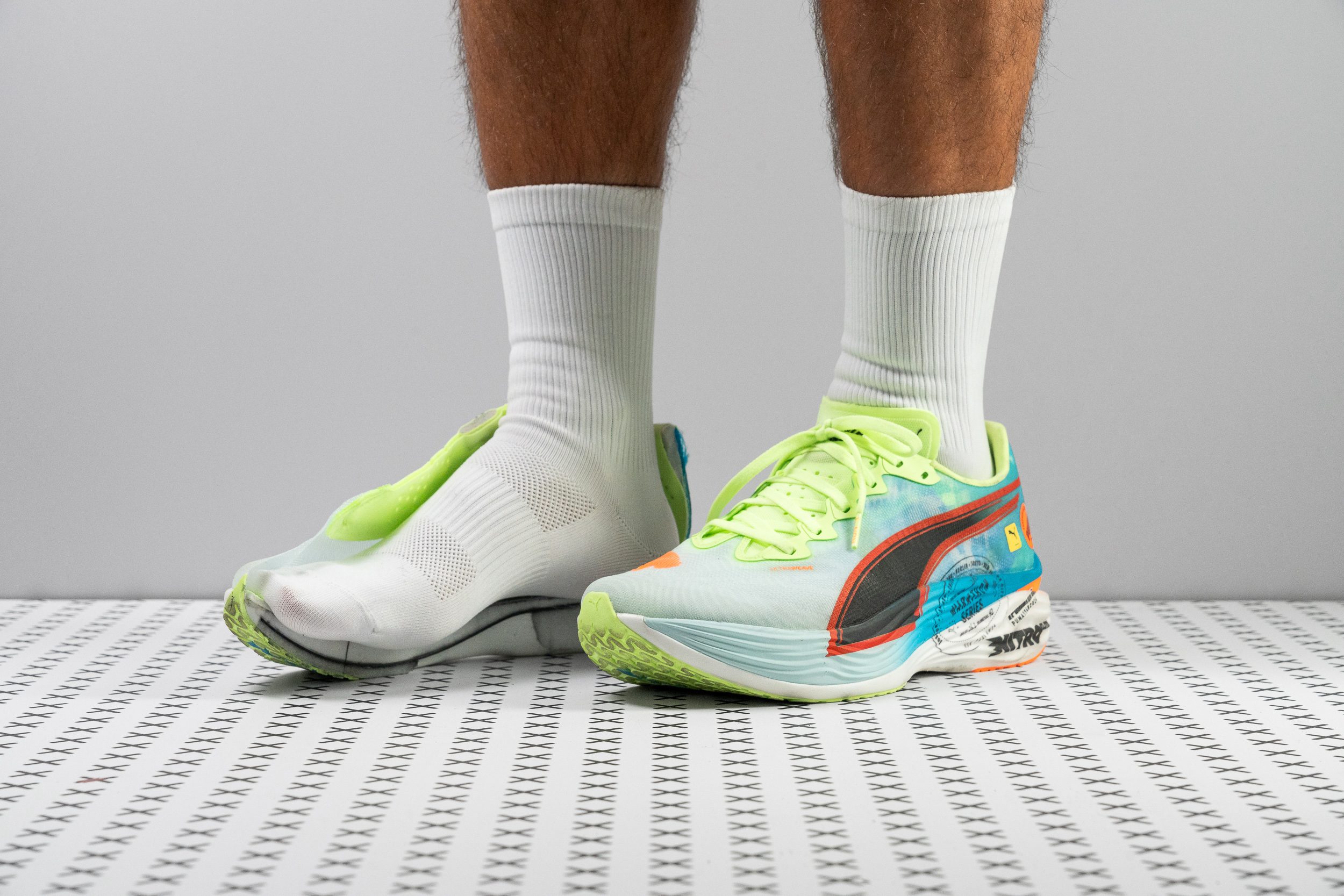





























































What makes it the best?
The PUMA Deviate Nitro Elite 3 proves through runs and lab tests that it’s the best value shoe for half-marathon running, priced at $230. It offers lightning-fast strides and extra sticky traction for better control at a more accessible price point vs. other supershoes. Its outsole can handle occasional speed training sessions too!
Weighing only 7.2 oz (240g), lifting each stride feels easy since it’s 23.0% lighter than the average running shoe. The stiff carbon plate launches us back with every landing with the rocker creating smooth turnovers, all enhancing the feeling of weightlessness. Our bend test verifies DNE 3 is 79.7% stiffer than average.
The Nitro Elite foam offers undeniable responsiveness, complemented by a soft 15.1 HA foam for impact protection and another balanced 18.3 HA base layer for stability. It ensures our muscles are protected and supported, especially as we approach the 13-mile mark.
The PumaGrip displays exceptional adhesion to the ground with its soft 72.6 HC nature. While this may make it more prone to wear, DNE 3 measures a thick 2.6 mm to prolong its lifespan. This is much thicker than typical sub-2 mm outsoles of racers.
With its focus on agility, the shoe’s narrow build demands good form. Those who need more guided strides should find more supportive shoes.
Pros
- Superb Nitro Elite foam
- Breathable, lightweight upper
- Extremely responsive
- More affordable than most supershoes
- Outstanding grip
- Great comfort for a racer
- Major improvements from v2
- Fast, agile, race-ready performance
- Fantastic tongue
Cons
- Not the best for heel strikers
- Durability concerns
- Lacks stability for some runners
In this guide, we talk about running shoes for half marathons. Specifically, shoes for running the actual half marathon, as in, racing! This means that the shoes covered here belong to the category of tempo shoes or competition shoes. If you’re looking for a daily trainer (to train for a marathon), consider reading our guide Best daily running shoes.
5 things to look for in half-marathon running shoes
Running a half-marathon means you have to run for at least 60-90 minutes (depending on your form), maybe even 2 hours. That means that the shoes you’re running in have to be:
- Comfortable so that you don’t end up with blisters or other injuries. Discomfort is out of the picture!
- Responsive so that they actually propel you forward instead of making your feet work more and causing premature fatigue. Premium foams are much better than standard foams at this!
- Breathable, especially if you’re running a half-marathon in hot weather.
- Cushioned so that they are able to absorb the impact as much as possible. We recommend at least 110 SA of shock absorption at the heel.
- Light so that they don’t weigh you down! We recommend looking for shoes that weigh less than 270g or 9.5oz.
There are other features you might be curious about and we will cover them all below.
4 tips for the best comfort
Here’s what we recommend checking when buying half-marathon shoes to ensure they are as comfortable as possible:
- Perfect lockdown. Your feet should not be sliding within the shoe (from left to right, or back-forward), and your heel must not be slipping.
- You should be able to tighten the laces as needed but without feeling a lace bite. If a tongue is too thin and tightening the laces causes discomfort on your instep, consider thicker socks or different shoes.
- There should be no hot spots. Make sure to check for pressure points. The toebox should also not press your toes from the top, as this can create black toenails (to start with).
- There should be enough room for your toes. While the tight and aggressive toebox design is bearable for short distances (in track and field), for 21 kilometers your toes should not be cramped. If it means looking for a wider toebox, so be it!
Toebox height test
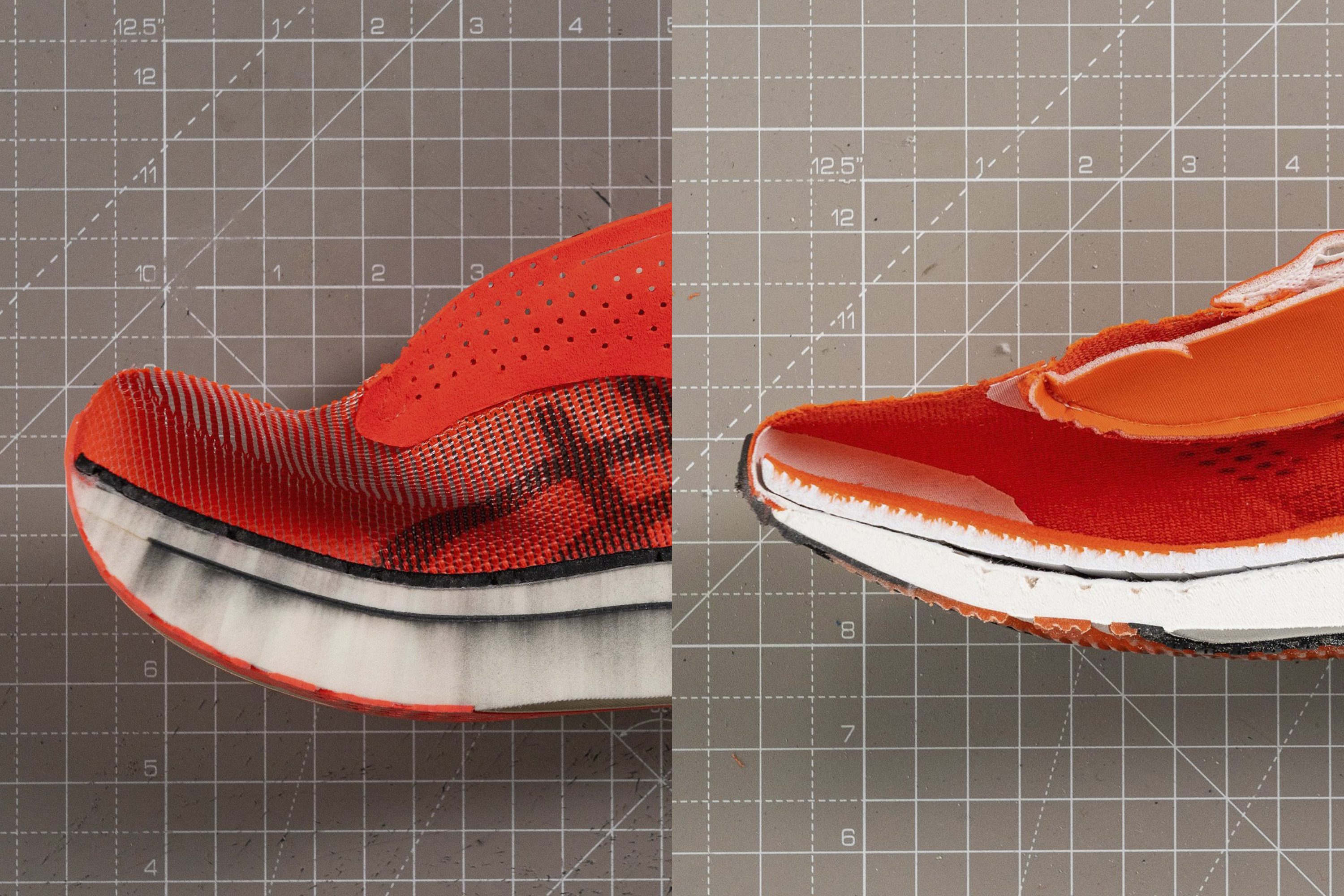
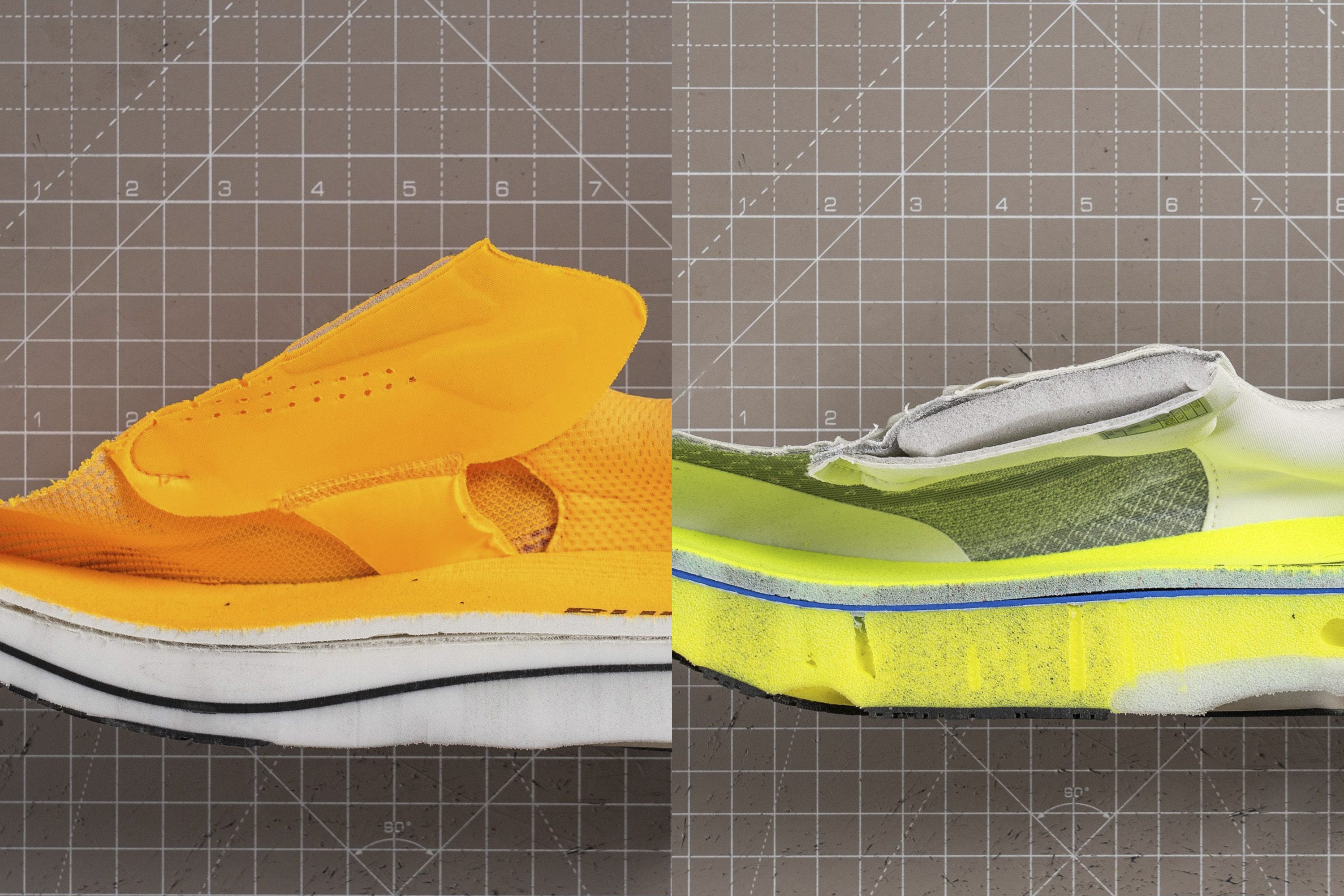
Tongues of different thicknesses: thin (left) which might cause a lace bite vs. very thick (right)
Wide toebox in half-marathon running shoes
Feet come in different sizes and shapes. Toes especially.
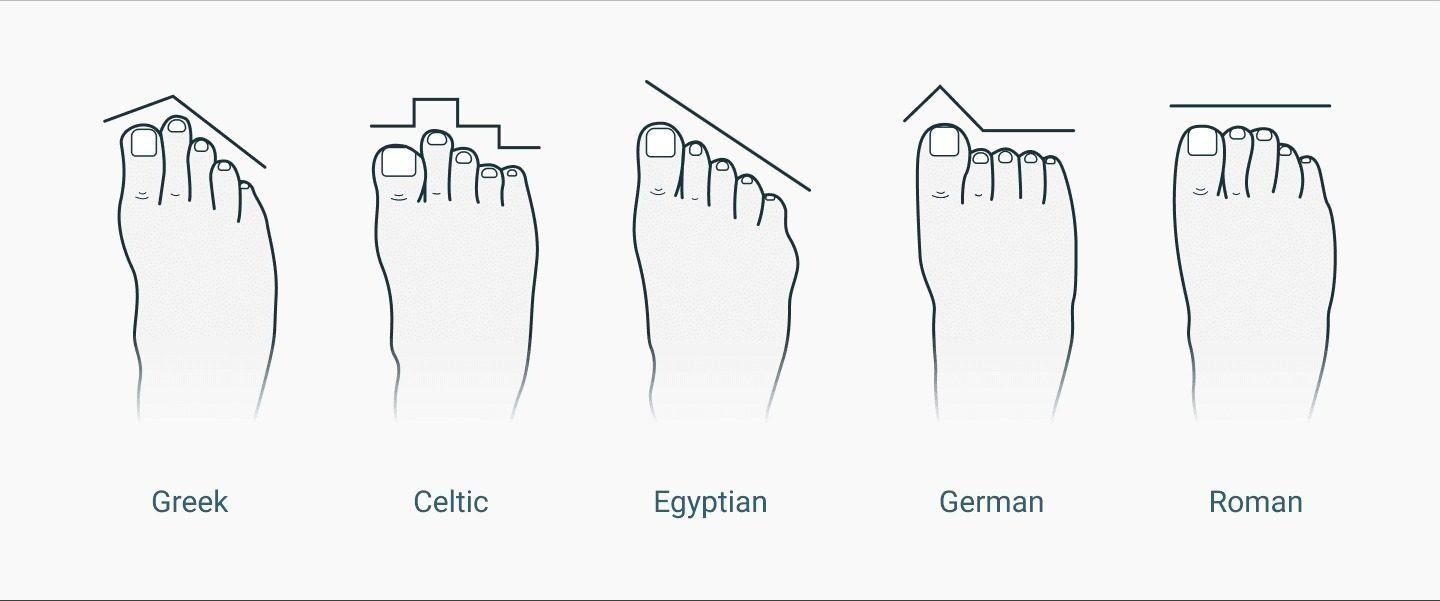
Because of this, it can be tricky to nail the toebox in running shoes. Whatever the shape of your toes, it’s important to allow your toes to sit in the toebox naturally, with no cramping. Maybe you need more room around the ball of the foot (where the shoe is the widest), or maybe you need more space at the big toe? In our lab, we measure both.
Making a special gel mold allows us to get the exact width and height measurements of every shoe and its toebox
Once the gel has hardened, we can take the mold out of the shoe and take measurements: both at the big toe and where the shoe is the widest.

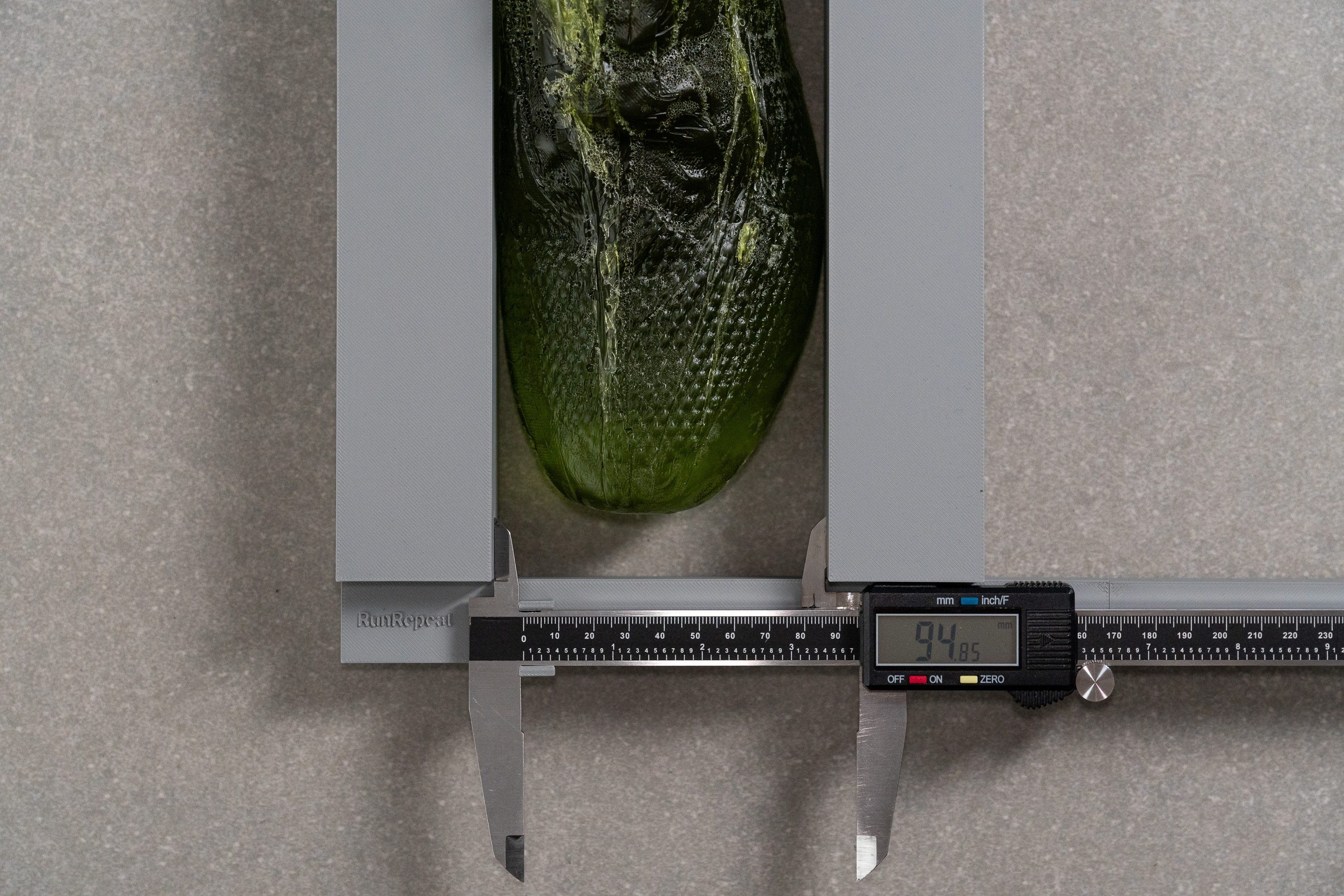
Depending on the shape of your toes, you may need more room around the big toe or at the ball of the foot.
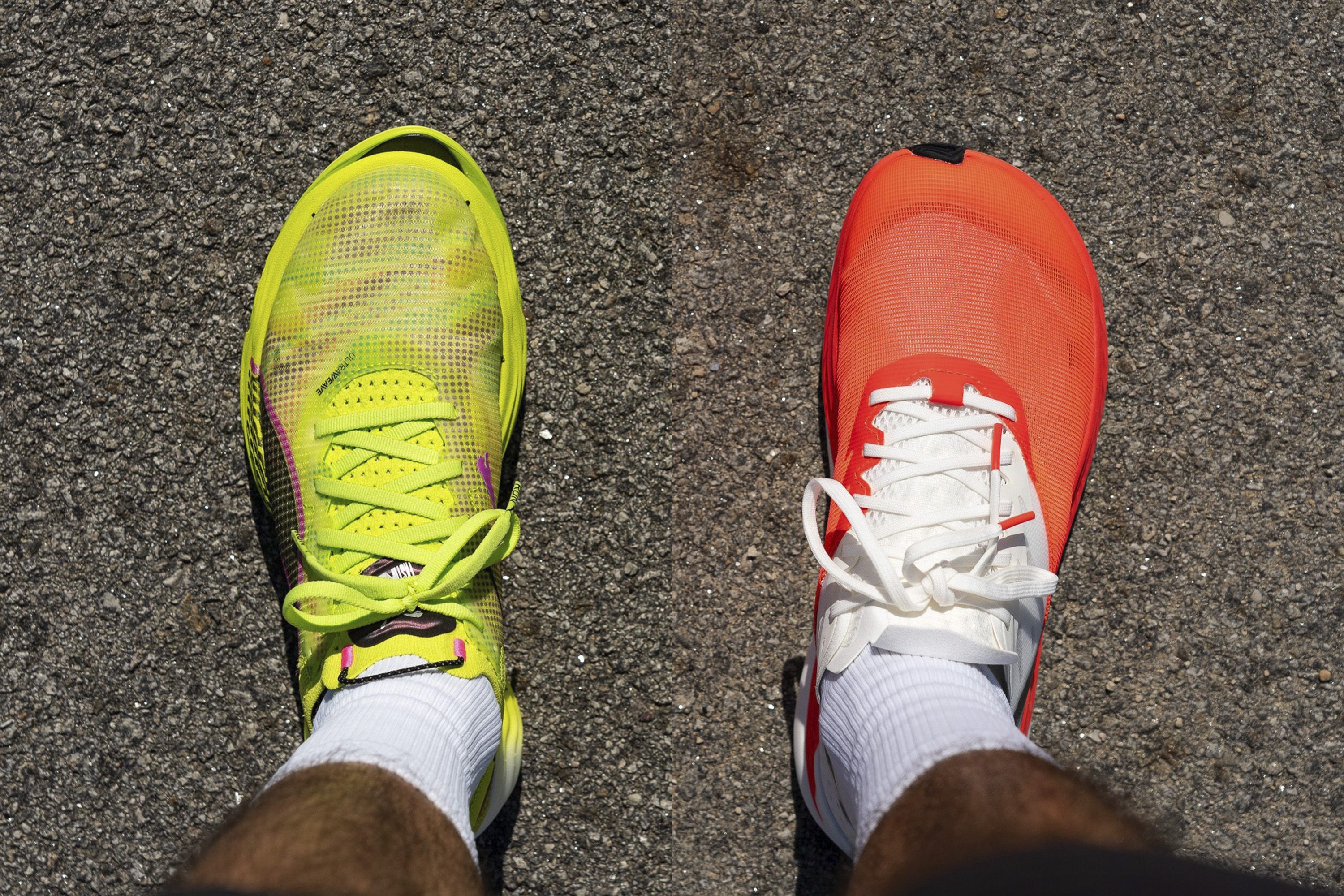
Note: we always test shoes in men's US 9, medium width.
Once this gel mold is cut in half, we can measure the height of the toebox as well. This is super important for runners who often end up a half marathon with a bleeding or a black toenail!

Pep, response, bounce! Energy return in half-marathon running shoes
The main difference between daily trainers and race (and tempo) shoes lies in responsiveness. And the key to responsiveness is found in the foam. We have 2 types of foams, standard and premium.
|
Standard foams |
Premium foams |
|
More often found in daily trainers |
More often found in tempo and race shoes |
|
Less responsive |
Much more responsive |
|
No leg-saving features |
Leg-saving features |
|
Affordable |
Pricey |
|
More durable |
Less durable |
Given the features listed in the table above, it’s easy to understand why we recommend half-marathon running shoes with premium foams.
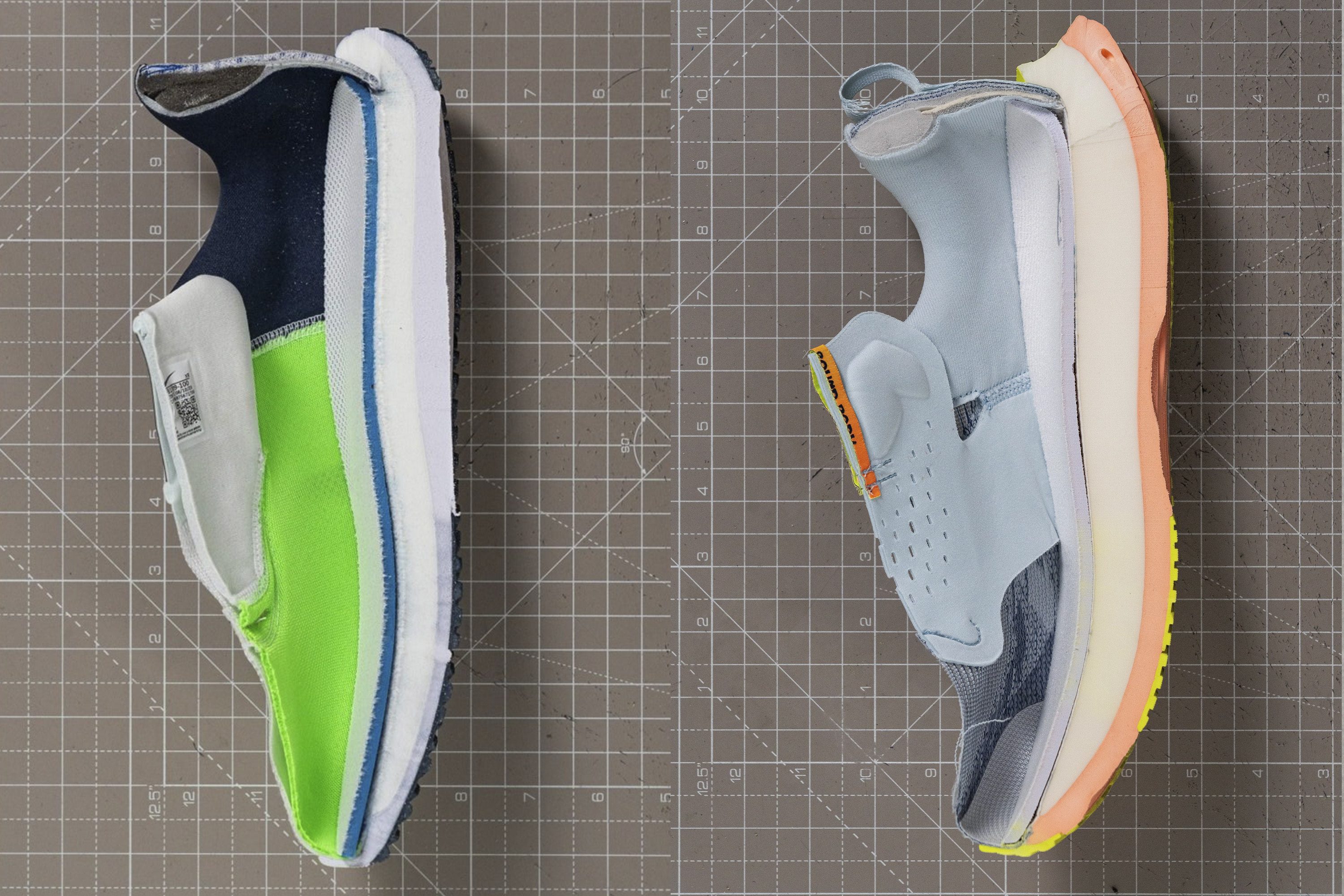
There's also a much more straightforward way of choosing running shoes with high energy return: consulting our lab test results. To test energy return and shock absorption in half-marathon running shoes, we drop an 8.5kg mass from a height of 5 cm, with a total energy input of 5 J, and export the results.
Lab test: energy return and shock absorption (SATRA TM144 methodology)
The higher the energy return, the better! It means the ride is more responsive, which is super important on race day.
Soft and stable platforms in half-marathon running shoes
Premium foams are often soft and sometimes made more stable with carbon-fiber plates. However, narrow platforms can make them unstable anyway, especially for heel strikers.
Noticeable lateral instability
Very soft and unstable foam (for heel strikers)
When it comes to softness, we measure it after cutting the shoes in half. This allows us to take the proper measurements as doing it on a whole shoe by sticking the durometer needle on the outside leads to inaccurate measurements.

If you prefer a softer ride, look for lower durometer readings. For a firmer ride, best to look for higher durometer readings!
If you prioritize stability, especially when cornering or covering slightly uneven terrain, it’s best to check the width of the platform.
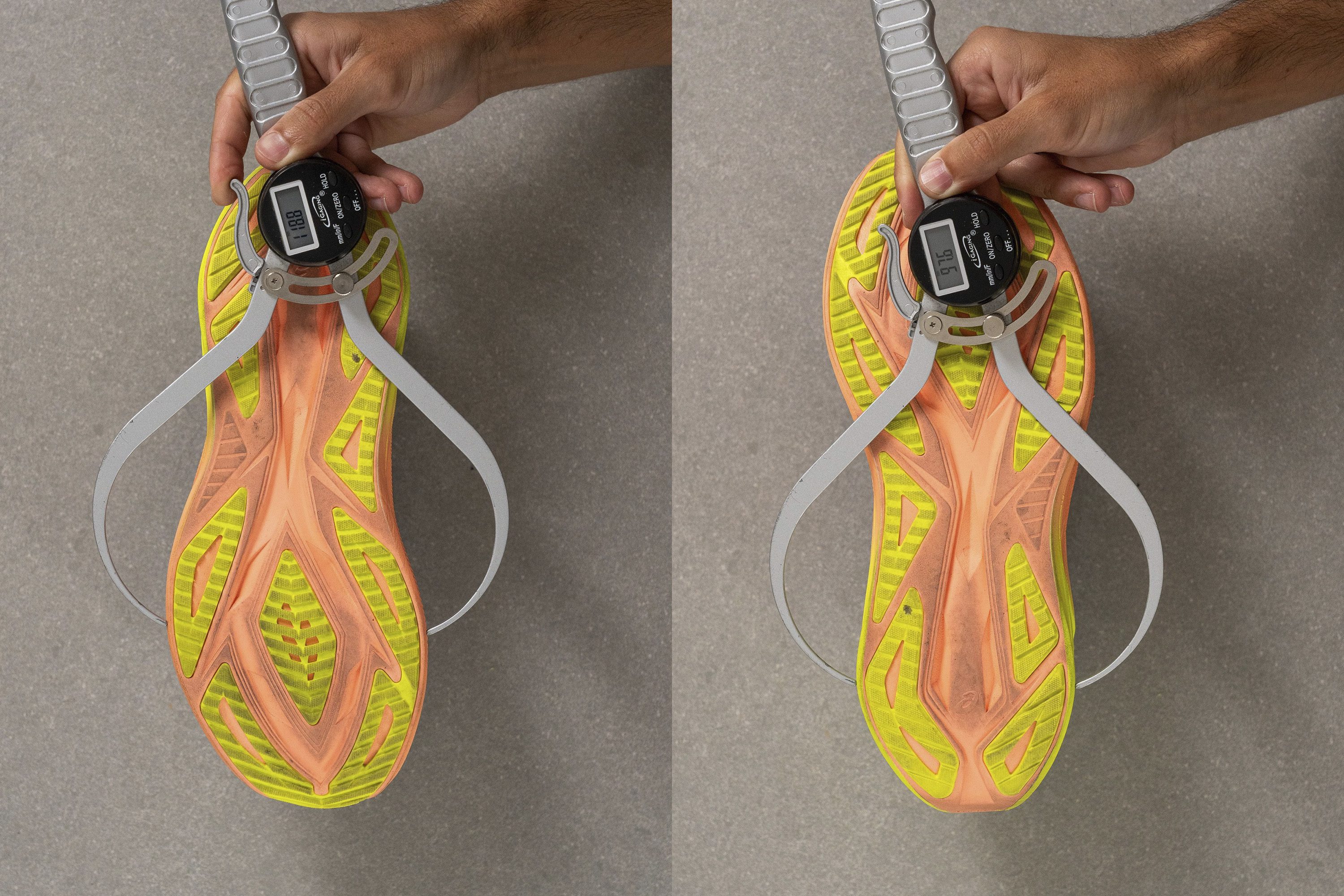
The wider the midsole, the more stable the ride!
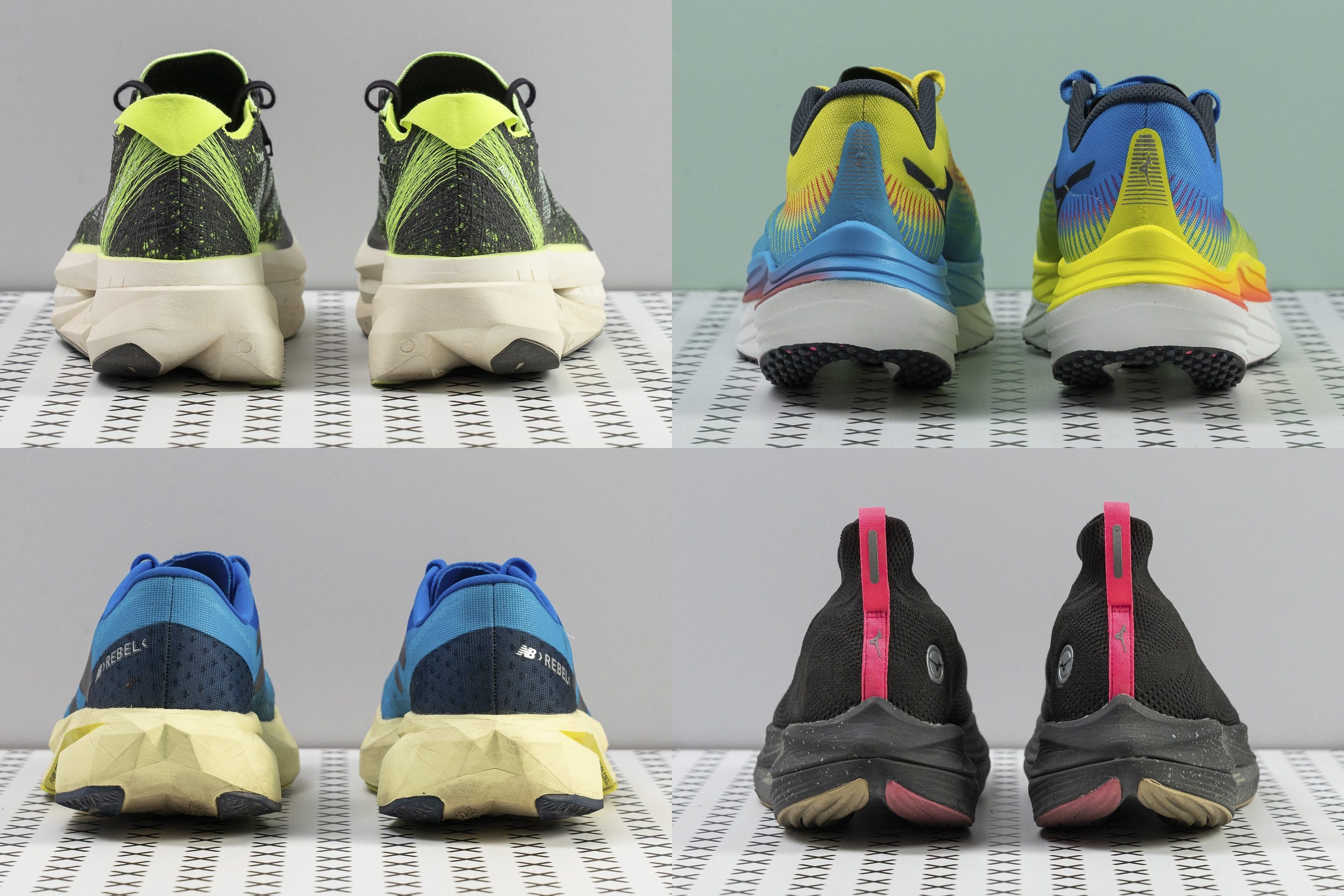
Warm vs. breathable running shoes for half marathons
If you’re planning for a race in (very) cold weather, you should look for less breathable shoes as they trap the heat. More breathable running shoes are great for sweaty feet and hot weather.
When assessing the breathability, we assign a 1-5 rating: 1 is not breathable and 5 is the most breathable. We also look at the uppers under the microscope.
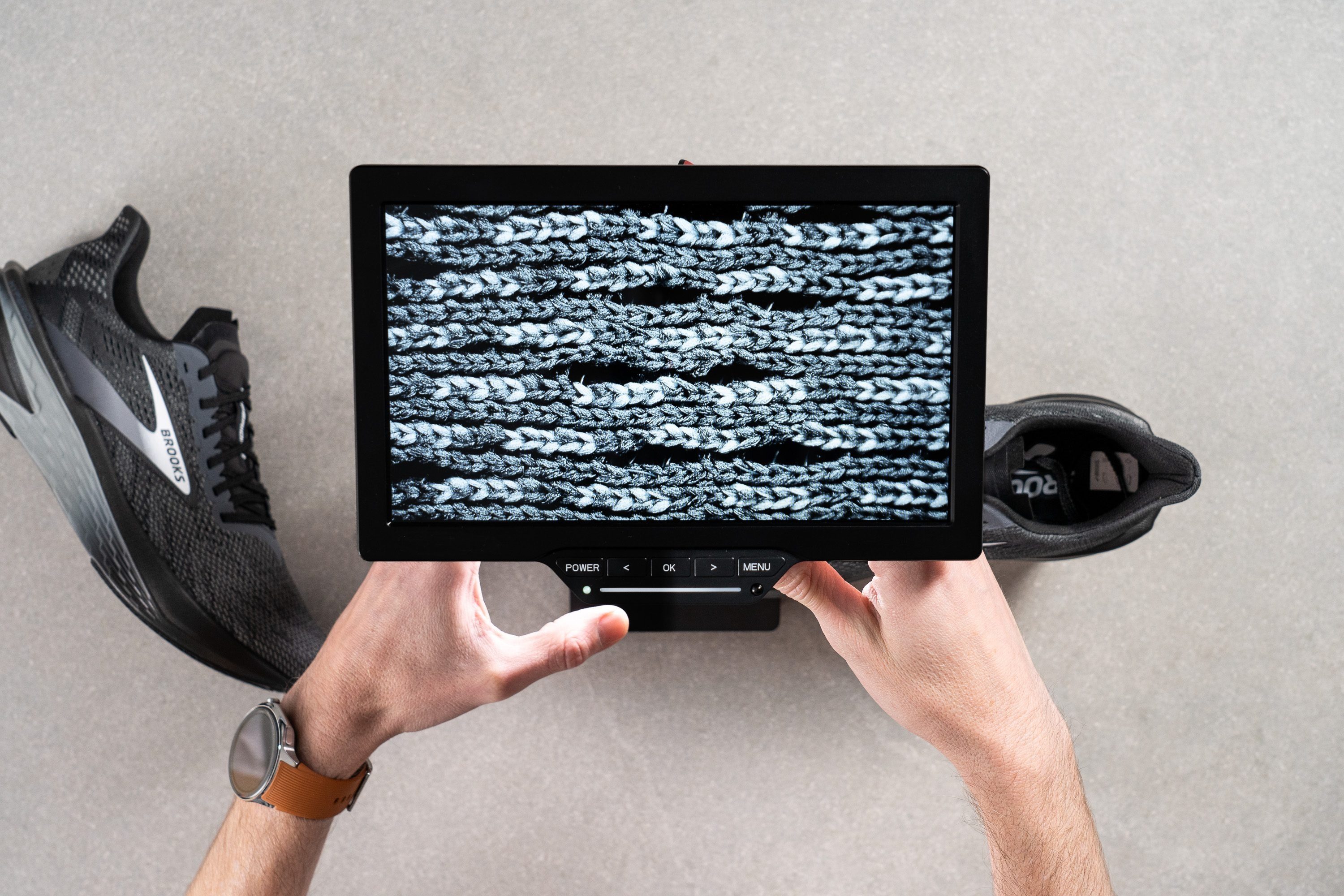
Very breathable running shoes often feature large ventilation holes or mesh uppers with a looser construction. Shoes that are not breathable have tightly packed threads that don’t allow the air to circulate. Sometimes they feature 2 layers, where the second one is often the waterproof membrane.
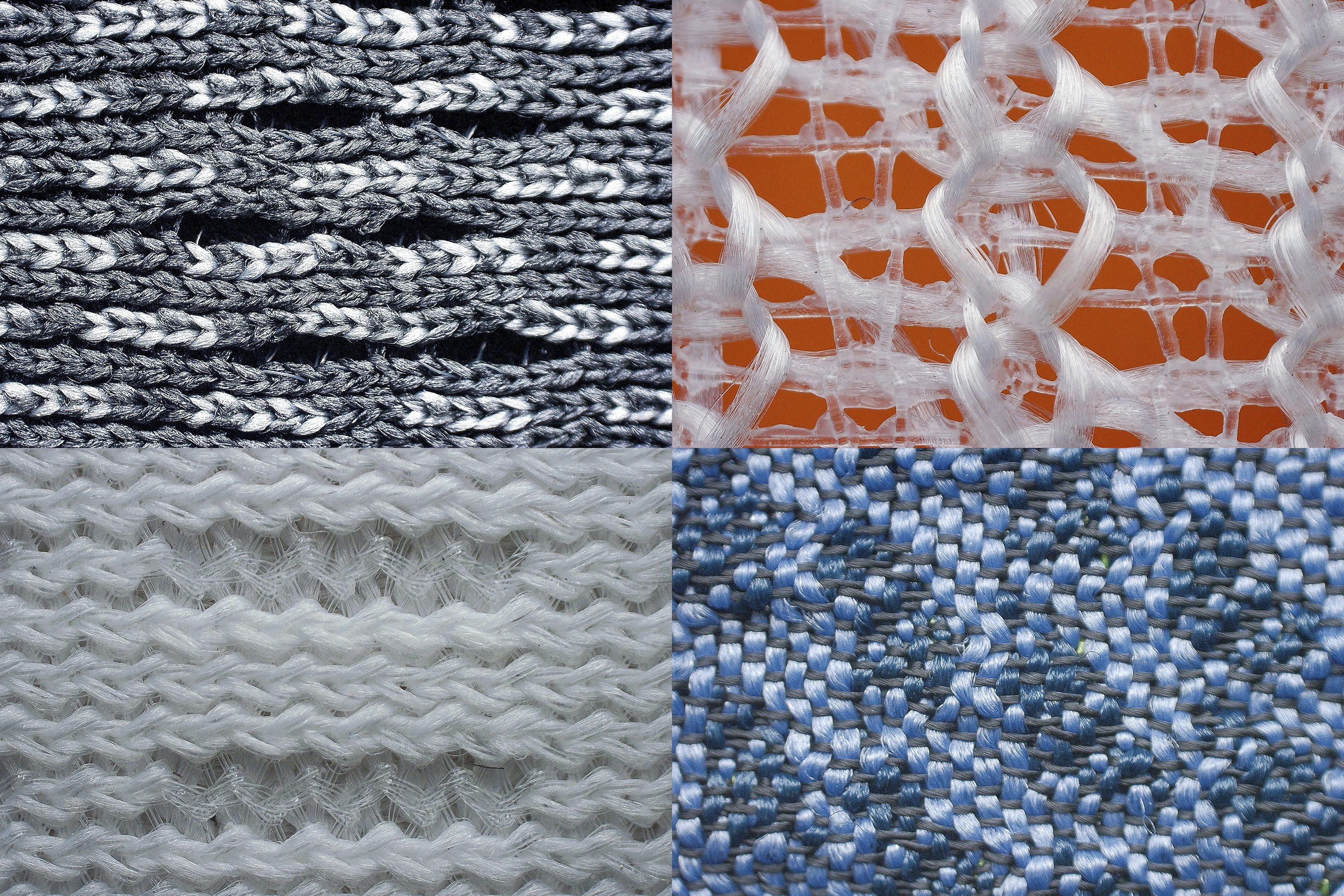
We don't see 1/5 and 2/5 often in half-marathon running shoes because running shoes for races have to be breathable and lightweight, so the upper is often very thin. The worst breathability ratings (1/5) that would imply the running shoes are great for cold weather are often found in daily trainers, especially the waterproof ones.
Finding good shock absorption in running shoes for half marathons
We recommend looking for shoes with at least 25mm at the heel. We do this with average runners in mind.
Note: If, however, you’re an experienced runner with tons of miles covered in minimalist shoes under your belt, then you might enjoy running a half-marathon in minimalist or even barefoot running shoes.
Running 21km on hard surfaces (asphalt, concrete) requires a lot of effort, and the impact forces generated at each landing need some absorption.

Fortunately, we are able to measure the shock absorption in our lab. The higher it is, the more forces will be absorbed by the midsole and not your legs, so what's not to love? And, above-mentioned high energy return resolves the issue of dull rides and midsoles that bottom out.
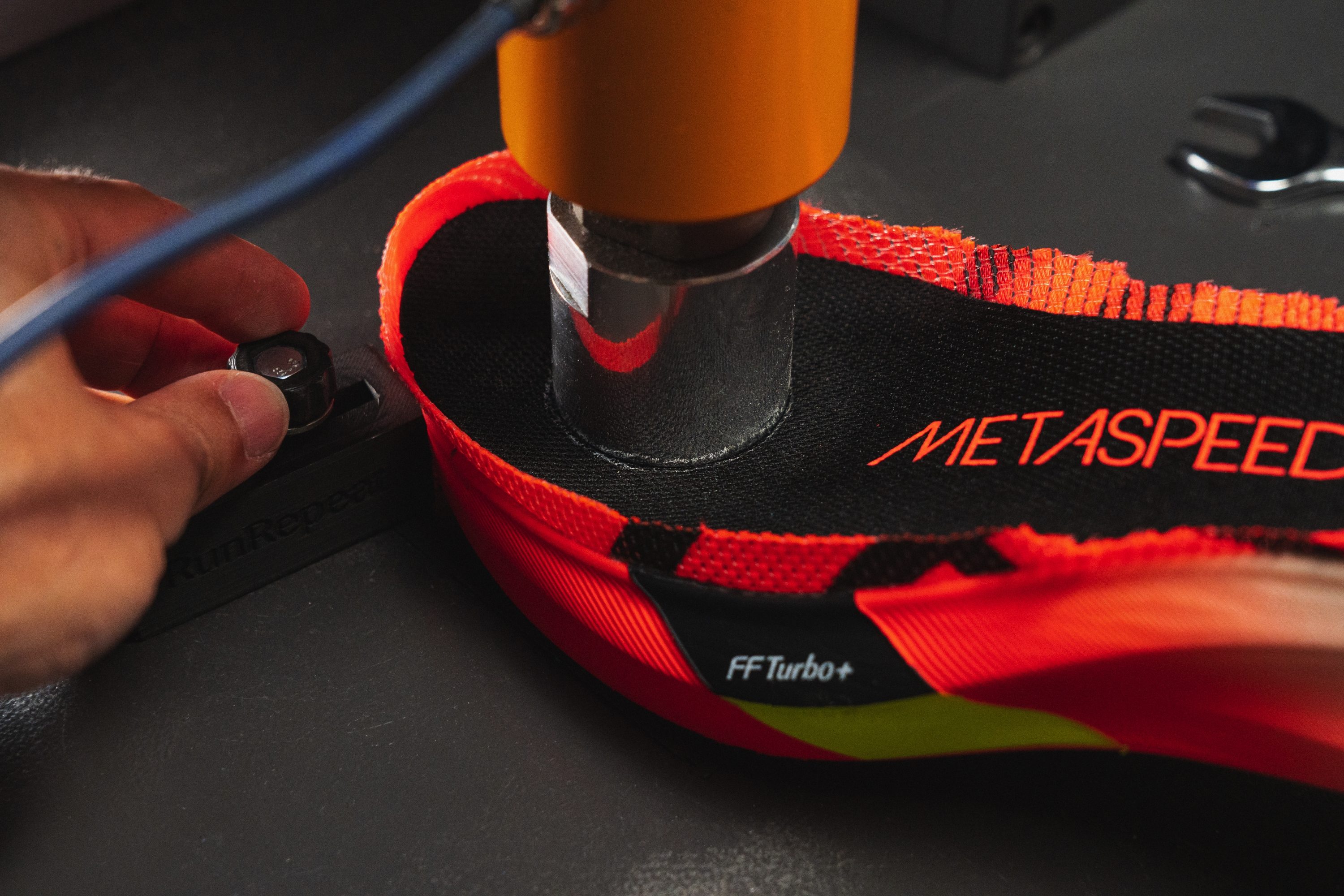
The ideal combination is high shock absorption and high energy return! It is race day, after all!
Weight of running shoes for half marathons
Heavier shoes make us run slower. We recommend looking for shoes that weigh 270g (9.5 oz) or less.

Of course, the lighter the shoe, the better. But, cutting the weight means you have to sacrifice some features of the shoes. Brands often remove the padding on the tongue and around the heel, or they make it much thinner.
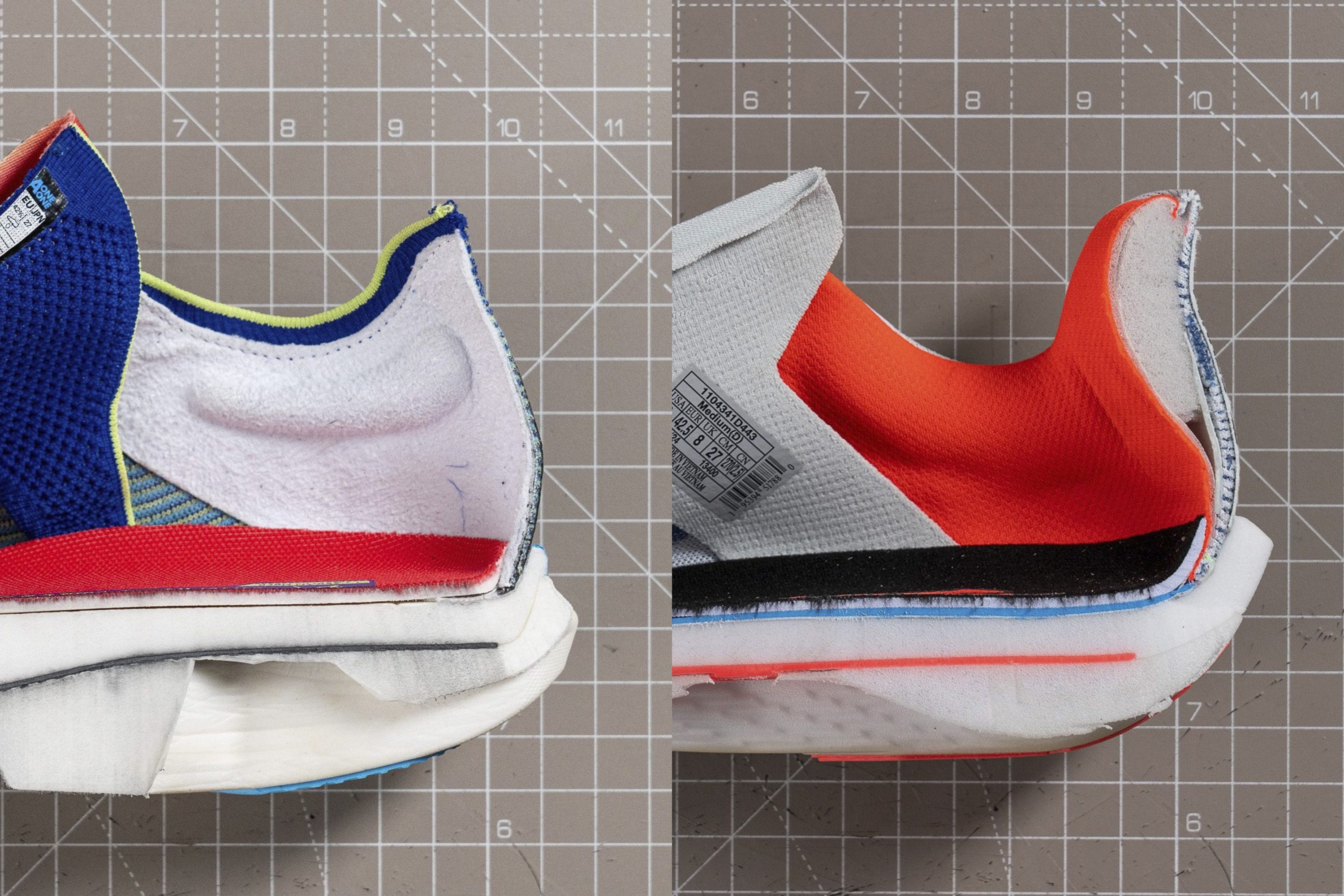
Brands also cut out the midsole, which, on one hand, helps with flexibility but, on the other, reduces the weight.
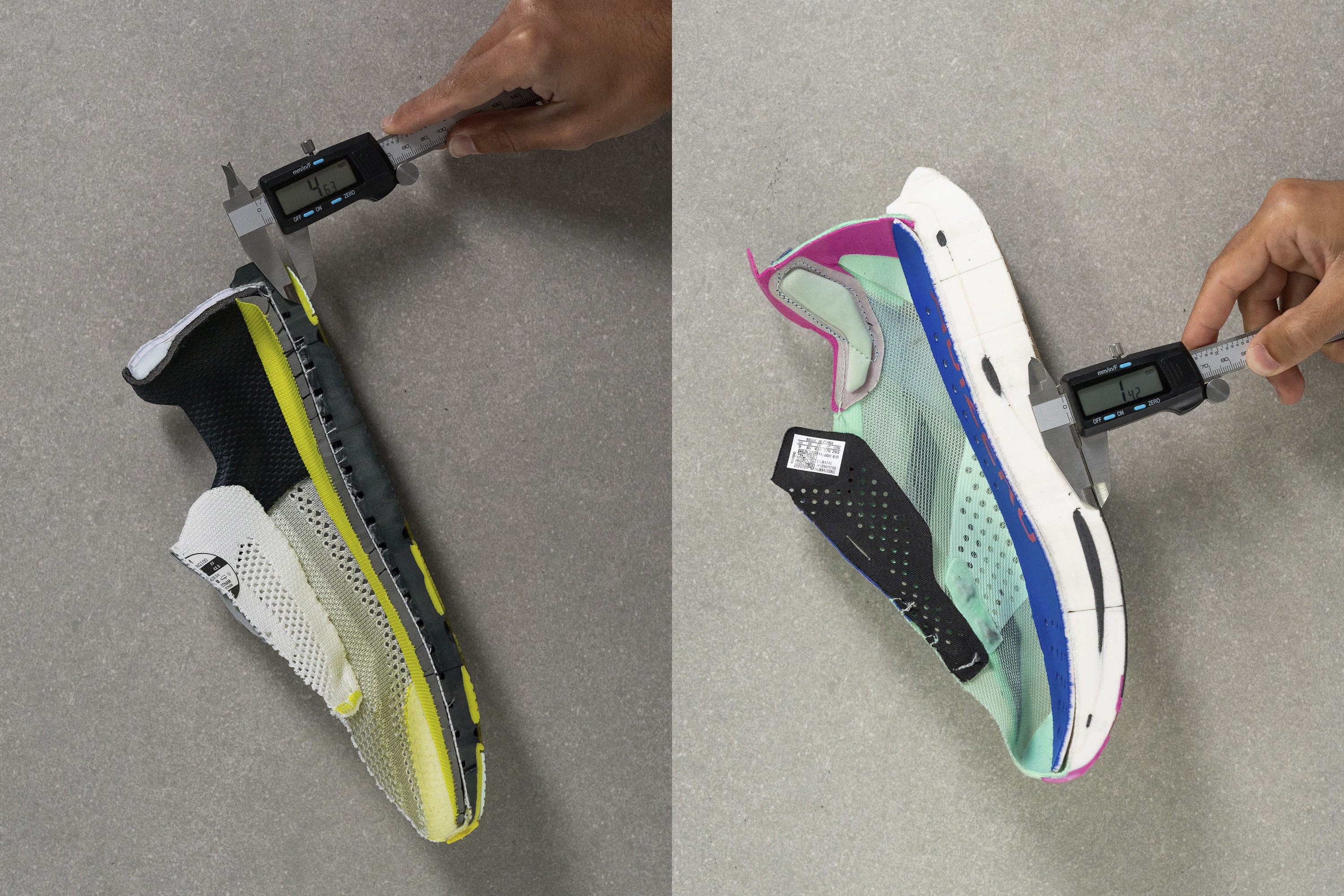
Some shoes have thinner outsoles which also improves the weight but makes the durability of the outsole worse because there’s less material to go through before reaching the midsole.
Shoe choices based on the foot strike
By now, you most likely know whether you’re a forefoot striker, a midfoot striker, or a heel striker. If not, please read our Ultimate guide on foot strike to find out and learn more about the foot strike.
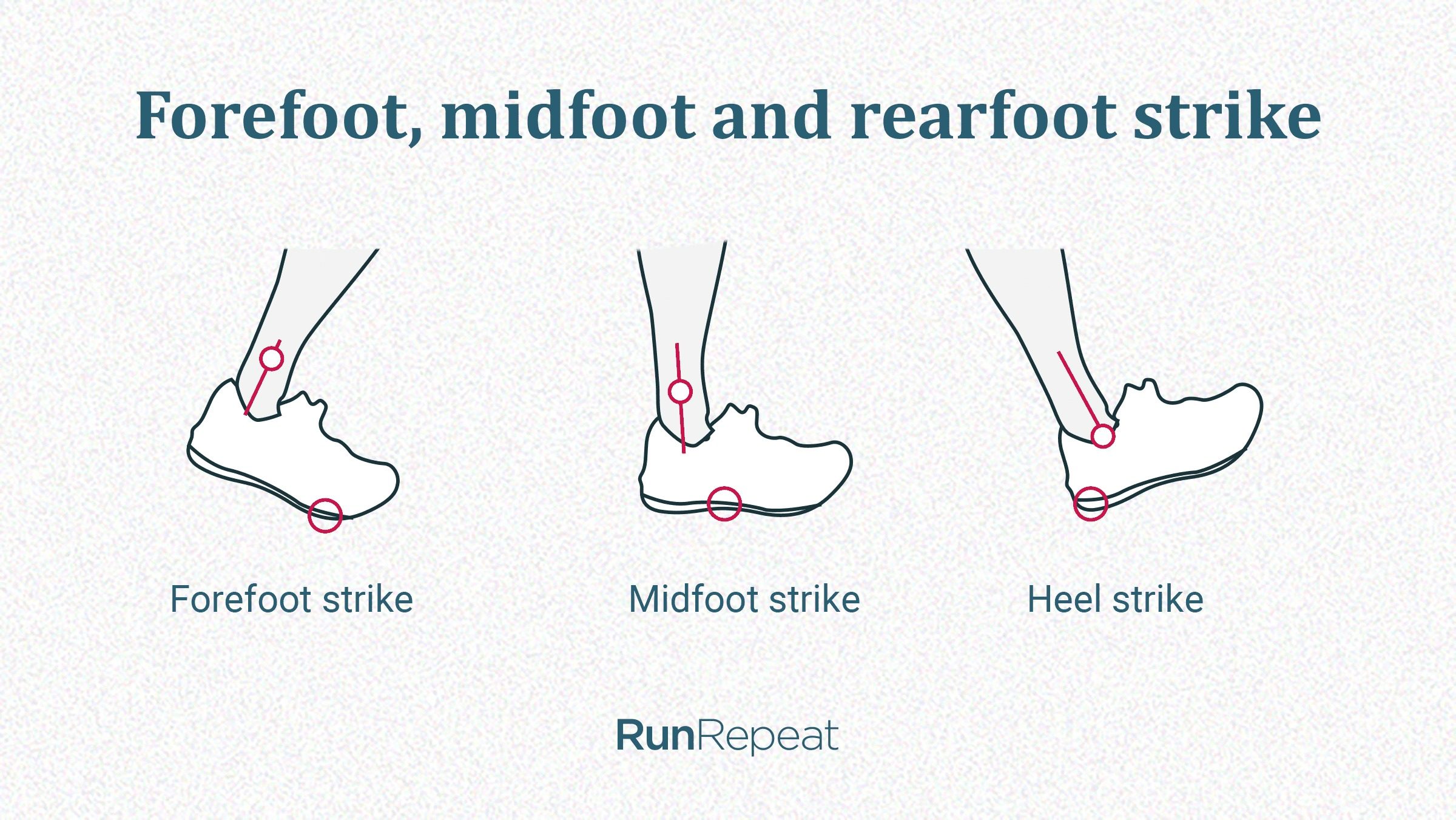
Basically, you should look for cushioning where you need it = where you land. If you’re a forefoot/midfoot striker, you need a good amount of foam at the front and having chunky heels makes no sense as they simply add more weight that you should happily ditch.
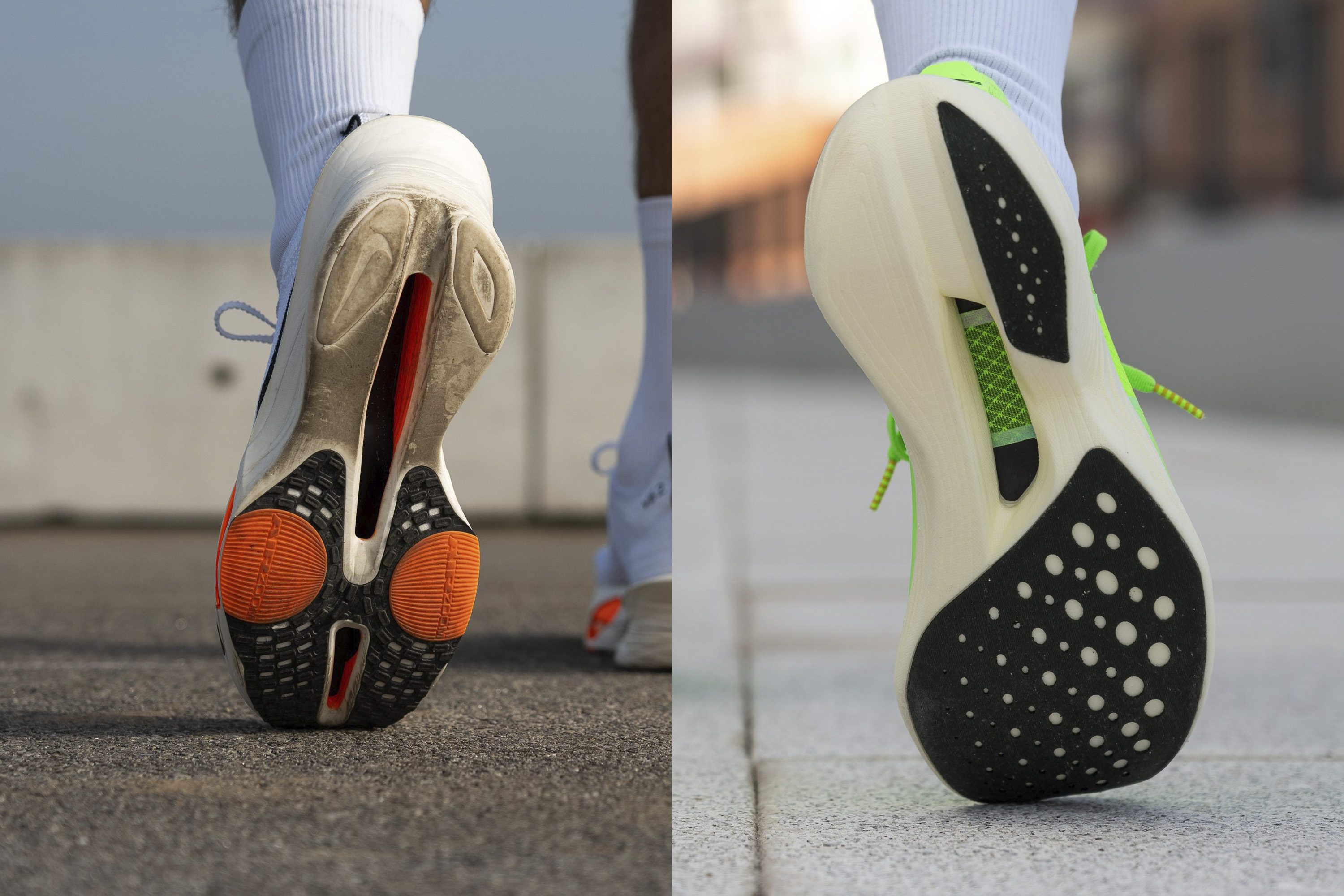
However, the biggest takeaway here should be the rubber placement at the bottom. Some shoes have it only at the forefoot, meaning they are prioritizing forefoot strikers. Other shoes have it along the whole surface, so they can be used by all runners, regardless of their foot strike.

If you’re a heel striker and you decide to run in a shoe that has no rubber at the heel, you might experience:
- Serious instability when the foam is very soft and there’s nothing at the bottom giving it some structure
- Slipping on wet surfaces because the exposed midsole offers no grip, it just slides
- Extreme premature wear because the durability of the exposed midsole is incomparable to the durability of the outsole.
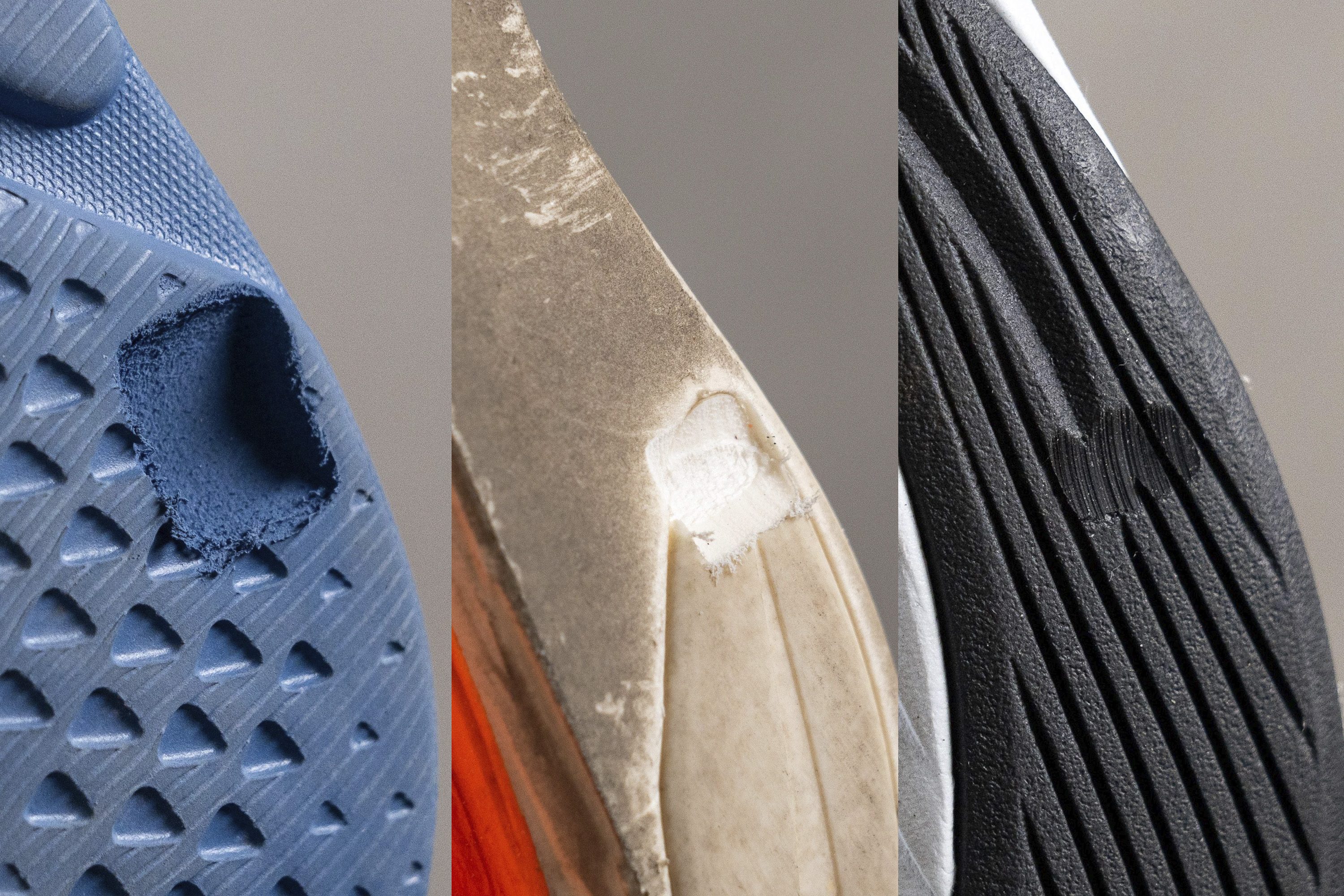
Should you choose carbon-plated shoes?
Depends on many things:
- Will you be able to make the best out of them? Many carbon-plated running shoes work best for fit runners (not too skinny, not overweight) who land on the forefoot/midfoot.
- Are you a fast runner? Race shoes with a carbon-fiber plate shine at fast paces! Some carbon-plated shoes are unstable and uncomfortable at slow paces, especially when walking.
- Can you afford them? The average price of a carbon-plated shoe is $217, while the average price of a non-plated shoe is $129.
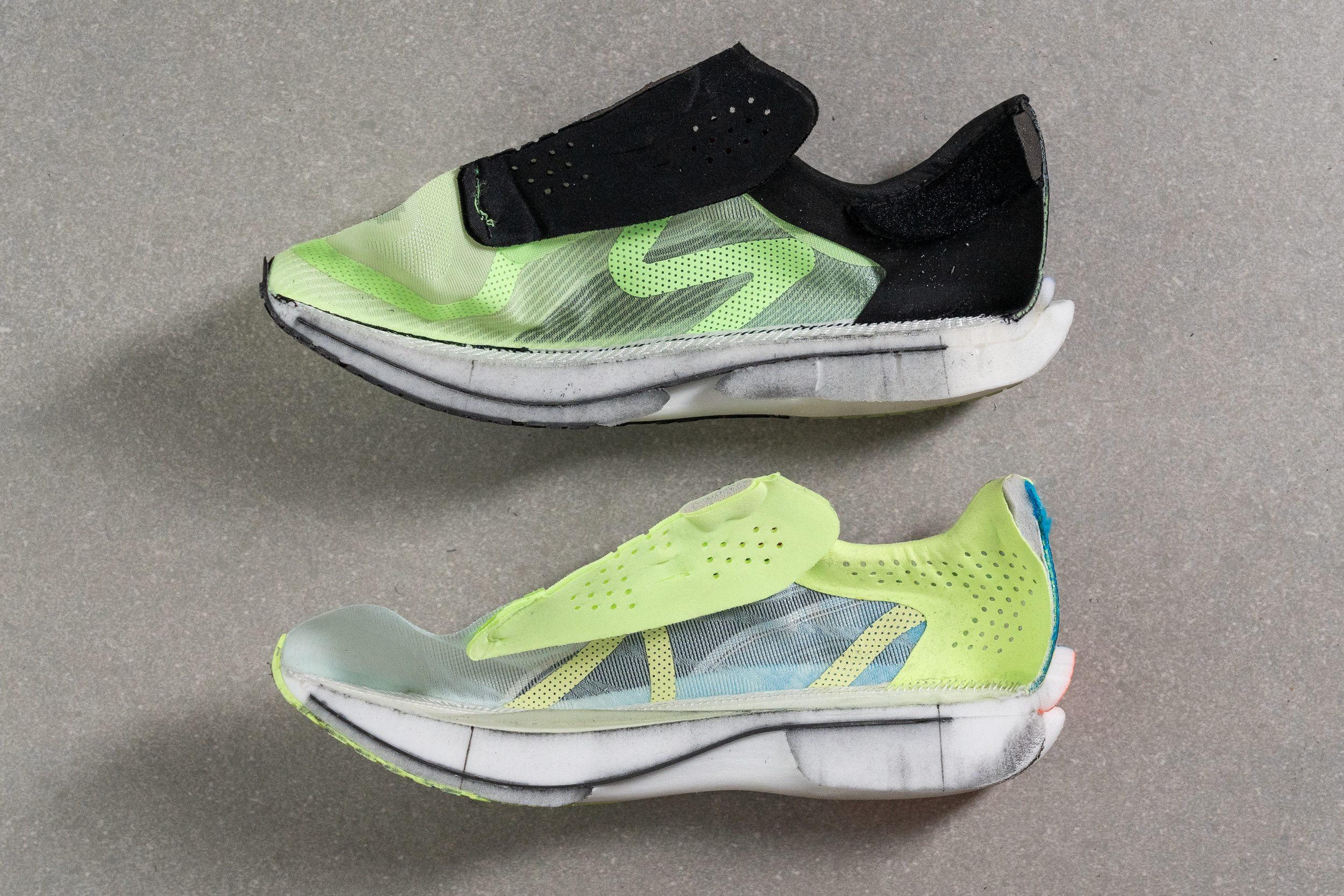
It’s also worth noting that these shoes are stiffer than average thanks to the plate and they work wonders when combined with a premium foam. See us play around with them! On average, we needed 20.8N to bend carbon-plated half-marathon shoes to 30 degrees, while we needed only 13.1N to bend non-plated shoes on average.
|
To learn more about this technology, we highly recommend reading our in-depth guide Carbon-Plated Shoes Cut In Half, Explained and Lab-Tested. |
Rocker: who it’s (not) good for
Many (new) shoes on the market today are rockered, some quite aggressively. It’s best to understand who rockered shoes are best for, so that you don’t end up buying something you don’t actually need.
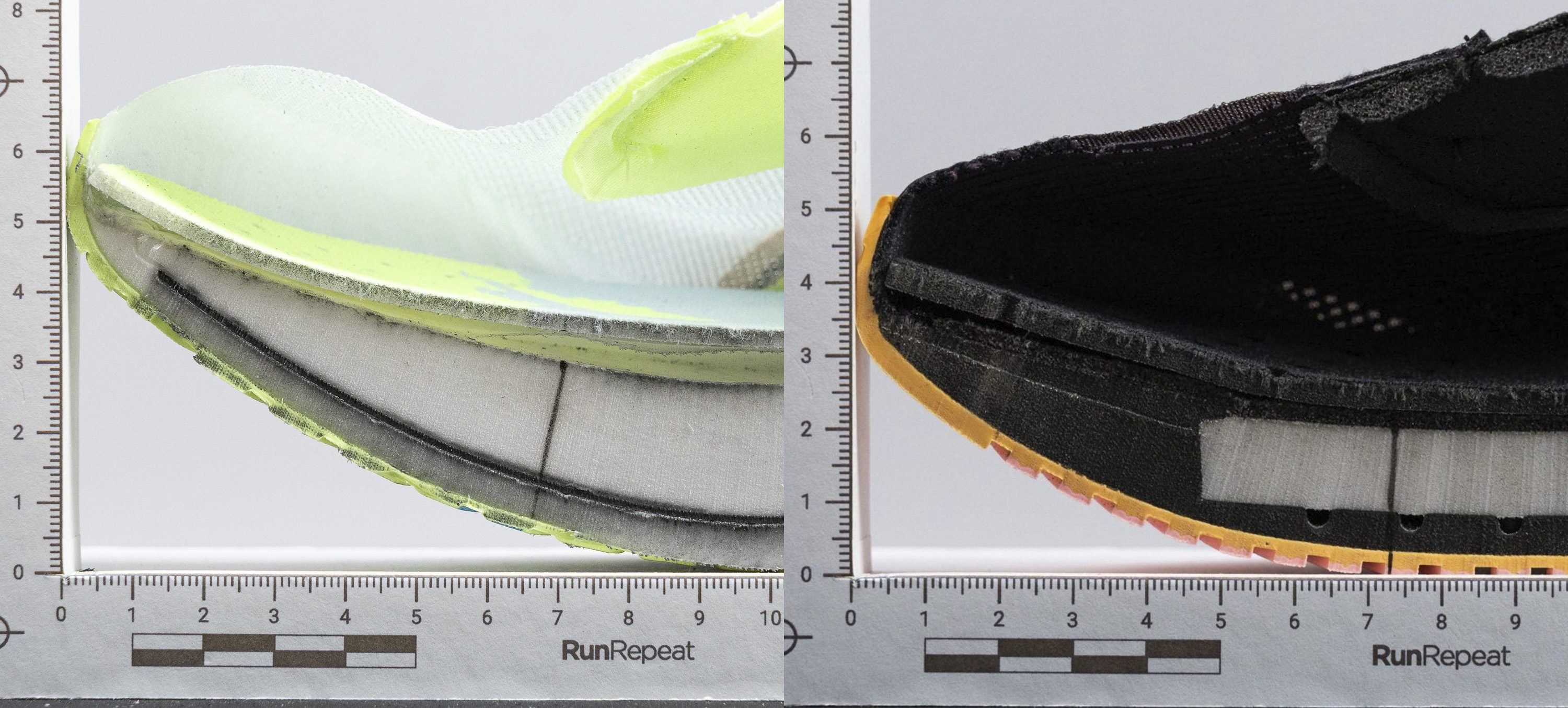
Rocker basically represents a curved bottom of the shoe which looks a lot like a rocking chair. The idea behind this design is simple: just like a rocking chair, the rocker is there to make transitions from the heel to the toes easier and faster.
Motion of a rockered and non-rockered shoe
Many heel strikers enjoy a rocker because a curved heel imitates the shape of our heel, it’s not edgy like some running shoes, but quite curved. This lowers the impact at the (heel) landing and is appreciated by many runners.
|
Rocker use |
|
|
Could be good for |
Might not be good for |
|
Plantar fasciitis |
Forefoot strikers, especially those with normal big toe extension |
|
Reduced big toe extension; toe or forefoot pain, like Morton’s neuroma |
Knee issues (runner’s knee, ITBS, meniscus tears, patellar tendinitis) |
|
Limited ankle movement |
ITBS |
|
Issues with Achilles tendons; calf or hamstring discomfort |
Hip issues (flexor strain, bursitis, labrar tear) |
|
Older (senior) runners |
|
We wrote a lot more about the rocker technology in our guide All you need to know about rockered running shoes.

